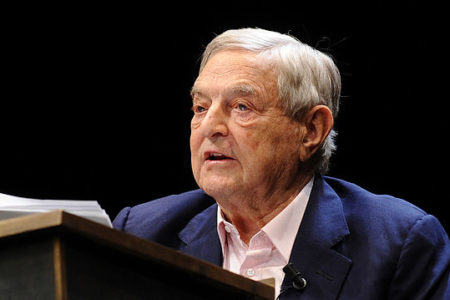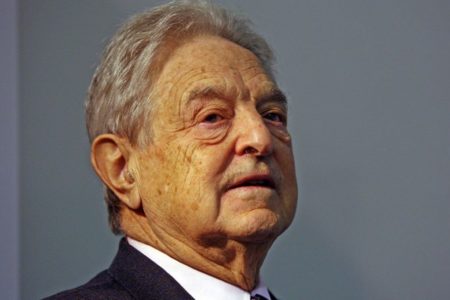The following article is intended to inform and does not necessarily reflect the views of Sovereign Nations.
 The Open Society Foundations is bigger than you think. In fact, it may be the largest philanthropic organization ever built, with branches in 37 countries. While the Gates Foundation spends more money, OSF has a larger footprint worldwide thanks to its many local offices, including throughout Africa. OSF’s budget will be around $930 million this year—which is substantially more than Ford’s total grantmaking.
The Open Society Foundations is bigger than you think. In fact, it may be the largest philanthropic organization ever built, with branches in 37 countries. While the Gates Foundation spends more money, OSF has a larger footprint worldwide thanks to its many local offices, including throughout Africa. OSF’s budget will be around $930 million this year—which is substantially more than Ford’s total grantmaking.
That budget is set annually by George Soros, who’s given away nearly $12 billion since he got into philanthropy decades ago. Nevertheless, thanks to his skills in financial markets, Soros—who recently turned 85—is now richer than ever, with a net worth estimated at $26 billion. The bulk of that fortune is slated to go one day to OSF, creating a massively endowed foundation that, in recent years, has been redesigned to exist in perpetuity.
While Soros himself is famous—or infamous, depending on your worldview—the giant foundation he funds is not as high-profile as you might expect. There are some reasons for that. In its communications with the outside world, OSF tends to spotlight the issues it cares about as opposed to its own doings. Don’t look on OSF’s website for press releases touting new grants or a blog where staffers muse about their theories of change. On the other hand, you may find articles about Islamophobia in Europe or the drug war in Brazil.
The foundation’s president, Christopher Stone, keeps a relatively low profile. Stone says he made a decision when he took over OSF in July 2012 not to participate much in events on philanthropy. “I’d rather focus my time in the field,” he told me in a recent conversation.
All that said, though, now’s a good time to take a close look at the Open Society Foundations. Under Stone, the foundation has undertaken a number of changes as it maps out its long-term future, preparing for a day when Soros is no longer around. In the past three years, Stone—who we called a champion “octopus wrestler” last year—has brought new governance and budgetary cohesion to OSF, working to systematize a foundation long known for its creative chaos.
But OSF is also at a pivotal moment because its grand cause, a vibrant civil society, has lately faced pushback from governments across the world. Authoritarianism is on the rise, and in many places, “civil society is under attack,” according to a report earlier this year from CIVICUS. Overseeing offices in every region of the world, with grantees in over 100 countries, Stone and the staff of OSF see plenty of first-hand evidence of this attack, which some experts warn will last through the foreseeable future. Indeed, OSF itself has come under attack in a few places, as governments have grown more determined to cut off foreign funding to civil society groups.
During the 1990s, George Soros was widely celebrated for his foundation’s role in bringing down communism and advancing the spread of democracy. More recently, history has been moving in the opposite direction, with the Carnegie Endowment for International Peace observing last year, “Dozens of countries that had previously allowed or even welcomed democracy and rights support activities inside their borders are now working to stop it.”
But Soros, now retired from his hedge fund and as active in the foundation as ever, has no intention of ceding the fight. Under Stone’s leadership, OSF is digging in for an extended battle to defend the basic idea of open society: That everyone should be heard in public life and no one should have a monopoly on the truth.
In short, what we have here is an epic drama in the annals of philanthropy: How can one of the most ambitious yet unwieldy foundations in history best deploy the wealth of one of America’s richest men to get the world back on track to a freer future?
A Mandate for Order
Chris Stone might seem to be an unlikely field marshal in a global battle for civil society, and just as unlikely to bring order to a sprawling foundation that, until recently, resembled Italy before Garibaldi came along. A lawyer by training, Stone has spent most of career focused on U.S. criminal justice issues. When he was tapped to lead OSF, he was teaching at Harvard’s Kennedy School, and he comes across more as a brainy academic than as the guy you hire to go up against, say, the thugs who run Turkmenistan.
But Stone is also a seasoned nonprofit leader, who earlier ran the Vera Institute of Justice, and while at Harvard, spent much time thinking about management as director of the Hauser Center on Nonprofit Organizations. As well, over the years, he had come to know the Open Society Foundations as a grantee and advisor. In discussing Stone’s appointment in late 2011, Soros called him an “outsider insider.” He also made clear that Stone’s mandate was to bring greater cohesion to the foundation. “We have a very complex organization,” Soros the New York Times. “It has become too complicated, and it needs to be streamlined, to become more unified.”
Stone became the second president of OSF, succeeding Aryeh Neier, who had led the foundation since 1993. For nearly twenty years, Neier and Soros had been one of philanthropy’s most dynamic duos, divvying up the world’s problems, with Soros charting OSF’s work on economic development and higher education, while Neier—who co-founded Human Rights Watch—took point on rights and political development. Together, the two men scaled up a formidable philanthropic organization—but one also known for its fragmentation and maddening, jerry-rigged qualities. Outsiders found it hard to understand the place; grantees and staff often had the same complaint. Even board members didn’t always know where grant money was going. In fact, no single board had full authority over the entire foundation.
Stone’s mission at the outset was to build an organization that didn’t revolve around the combined institutional memory of Soros and Neier—a more professional foundation that, as Stone says, is “working with a meaningful budget” designed to advance “a meaningful strategy that is clear and expressed,” which the board had “a meaningful role in shaping.” Most importantly, Stone’s job was to ensure that OSF was set to thrive when Soros was no longer active so the organization could carry forth his vision.
Building such a permanent foundation, it should be noted, was never part of Soros’s original plan. Back in the 1990s, Soros said that he had no interest in creating an endowed foundation that would exist in perpetuity, and instead planned to give away most of his fortune while he was still alive. More precisely, Soros had once aimed to wind up his philanthropy by 2010. But he changed his mind on this subject, publicly announcing in 2005 that the foundation would go on in perpetuity.
One big reason for this shift in Soros’s thinking was that he saw a clear role for OSF well into the future. The battle for civil society, it had turned out, was anything but a linear forward march of progress—notwithstanding early post-cold war talk about the “end of history” and the inevitable triumph of democracy and free markets. On the contrary, a number of former communist societies had, by 2005, morphed into authoritarian states with crony economies. A new pushback to civil society was also gaining steam at that time in Latin America and Africa.
Another reason that Soros came to favor a permanent foundation is that he felt it would be wrong to pull the plug on the individuals and groups, in so many countries, that had to come to rely on OSF funding. In a lot of places where it works, OSF is the single largest backer of civil society.
With the shift to a perpetuity model for OSF, came an imperative to build a stronger, more durable institution. While Soros has not signed the Giving Pledge, Stone says that the board and staff have “every expectation that the bulk of his fortune will be left, one way or the other, to the foundation. And we are building an organization capable of governing and deploying that resource as responsibly as possible to fulfill his mission.”
How much wealth the foundation may one day command is unclear. But consider this: George Soros’s fortune has more than tripled in the past decade. He made a stunning $4 billion in 2013 alone, during his first year that he was officially “retired” from running his hedge fund. If the past is any guide, Soros’s current net worth of $26 billion could yet grow into a far larger pile of money by the time that he dies and most of that wealth passes to the foundation. Which means that, one day, OSF could easily have an endowment that is twice the size of Ford’s—and possibly rival that of the Gates Foundation, which stands at $43 billion.
Stone, who is now starting his fourth year in what is surely one of the toughest jobs in philanthropy, says that OSF has made good progress toward unifying itself and streamlining its operations. The foundation has put in place a stronger system of board governance, as well as a unified budgetary process. Soros himself is more involved with the foundation than he has been in years, talking with Stone nearly every day and traveling to the foundation’s far-flung local offices. But he’s also committed to the long-term shift of authority to OSF’s governing board. The foundation may still be a place where, occasionally, the left hand doesn’t know what the right hand is doing, but those days are coming to an end.
Civil Society on the Defensive
When George Soros first got started as a philanthropist, in 1979, over 400 million people lived under communist rule in the Soviet Bloc and apartheid was firmly entrenched in South Africa. A lot has changed for the better since then, and OSF has been involved in much of that change. Fundamentally, this is an institution that is optimistic about the possibilities for progress.
But, with a presence in so many countries, OSF is also uniquely positioned to know when things are heading in the wrong direction, as has been the case lately. Looking back at 2014, CIVICUS documented “significant attacks on the fundamental civil society rights of free association, free assembly and free expression in 96 countries.” Pressure on civil society organizations has increased in major countries like China, Russia and India, but also in many smaller ones, like Hungary, Kenya and Cambodia.
CIVICUS says that a range of tactics are leveled against independent organizations, including efforts to disrupt funding flows, new regulatory restrictions, and violence. Stone sees the same thing in the treatment of OSF grantees. Some are harassed by tax authorities and other government agencies; some are directly attacked by government officials in speeches. “We’re seeing a more sophisticated attempt to limit people’s ability to free and open discussion than we’ve ever seen before,” Stone says.
One line of attack on civil society groups has been to demonize their funding sources, and OSF is an easy target, given George Soros’s controversial profile, although other U.S. foundations have come under fire, too. Last year, the government in Azerbaijan froze the bank account of the local OSF office in Baku, seized its computers, and questioned former employees. That move was part of a broader attack on civil society that included the arrests of dozens of political activists, human rights advocates, and journalists. Stone says that OSF has now left the country.
Meanwhile, OSF has been battling new efforts to undermine its work in Russia, where it has had a presence for a quarter of a century. That presence used to take the form of a large office with over 100 staff. But “all that is gone now,” says Stone. In July, OSF was included on a list of 12 organizations that the government was considering banning. No such ban has yet happened, and last month, the foundation said it is determined to “continue its work in Russia.”
Stone stresses that, in general, there is nothing wrong with regulation of civil society. Every country, including the U.S., engages in such oversight. The problem is when this power is abused to squelch voices of dissent.
And why is that increasing around the world lately? It’s a pressing question, and Stone says that the foundation is engaged in wide-ranging conversations to better understand the crackdown on civil society. No single explanation holds sway within OSF and nor, for that matter, does everyone in its orbit embrace a view of doom and gloom. Some veteran local staff have watched things get better in their countries, not worse. “People across the foundation have seen different rhythms of gains and losses,” says Stone, and “there is no party view” of what’s happening.
Some scholars are more pessimistic. A report last year from the Carnegie Endowment for International Peace said the closing of civil society space was “global” in scope and that the effects of restrictions against democracy and rights were likely to persist for the “foreseeable future.” One view about the latest wave of crackdowns is that more governments have come to understand the power of civil society groups, especially in the Internet age, and are anxious to reaffirm their own primacy. In a Foreign Affairs essay earlier this year, “Dark Days for Civil Society,” Sarah Mendelsohn wrote:
“…as citizens find new ways to organize, assemble, and express themselves through the use of affordable technology, governments have found new ways to restrict public political space and suppress information. And those regimes are sharing lessons learned; in the last few years, for example, numerous governments have mimicked or copied laws enacted in other countries that seek to shrink the administrative and legal space in which NGOs work.”
The Long Fight Ahead
Regardless of what’s driving the crackdown on civil society, or how lasting it may be, one thing is clear: More needs to be done to stick up for democracy and rights worldwide. So far, though, the international response to this slow motion crisis has been “inadequate,” according to the Carnegie report, which said: “competing interests, diverging donor perspectives, and a lack of coordination have weakened responses.”
Carnegie’s recommendations for a stronger defense of civil society focused mainly on steps that might be taken by governments and international agencies. But where does philanthropy fit in here? How much can even the world’s biggest foundations do to get history moving back in the right direction?
That’s another pressing question, and it’s not clear anyone really knows the answers, although there is plenty of discussion among the foundations that care about civil society—a group that, besides OSF, includes Ford, MacArthur, Mott, the Carnegie Corporation, and the Rockefeller Brothers Fund.
In our conversation, Stone didn’t unveil any grand strategy by OSF to push back against authoritarianism and boost civil society. Nor did he suggest one was in the works. Rather, it seems the plan is for the foundation to just keep doing what it’s been doing, pumping out almost a billion dollars a year for democracy and human rights on nearly every continent in the world.
Could the foundation be more strategic? Maybe so. But fancy blueprints for grantmaking have never been what this outfit is all about. OSF’s strongest asset, after Soros’s billions, may be its sheer tenacity. Even in very hostile environments, like Tajikistan, the foundation’s local offices manage to hang in there, year after year, patiently making whatever gains are possible. Nor does OSF forget about those countries where it’s too hot to operate, like Turkmenistan—now one of the most repressive of all former Soviet republics under the rule of President Gurbanguly Berdimuhamedow.
Recently, the foundation backed a documentary to help bring attention to Turkmenistan’s horrific prisons. The film tells of thousands of prisoners trapped in a deeply violent and inhumane system, one cut off from international monitoring. It’s a place where suffering inmates are serving long terms, often on trumped-up charges, and worry that they’ve been forgotten.
Only they haven’t been forgotten, at least not by one of the richest foundations in the world. What’s more, OSF—now revamped to carry on its mission forever—will be around long after today’s dictators like Berdimuhamedow are gone from the scene.
We don’t know what the future holds for civil society in the 21st century. But we do know who’s going to be in that fight for the long haul.






Recent Comments